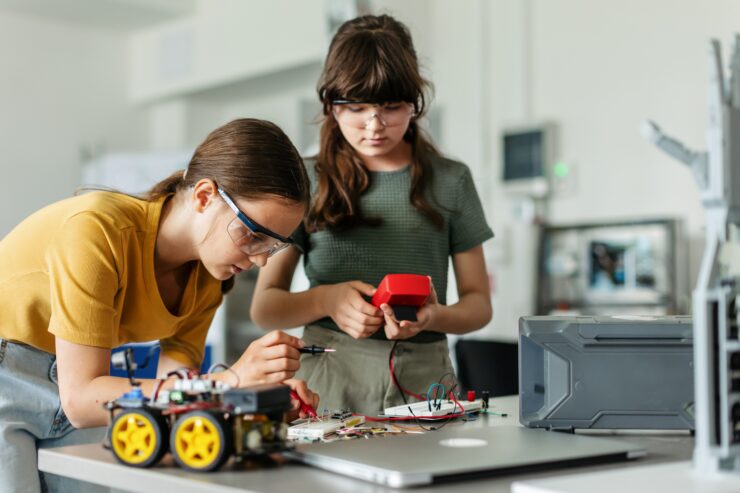Creating a classroom culture that fosters a growth mindset
How teachers can shape learning environments that engage students and reduce educational inequalities

Identifying ways to foster students’ growth mindsets to help them become more academically resilient and successful is a major breakthrough in research, says Cameron Hecht. But he points out that helping students navigate less-than-equitable contexts is not enough; researchers can also find ways to make educational contexts more equitable. Cameron tells Annie Brookman-Byrne about his work helping teachers to create environments that are more supportive of all students’ success.
Annie Brookman-Byrne: How have you built on growth mindset research in your work with teachers?
Cameron Hecht: Students from marginalized groups face significant barriers that prevent them from fully accessing and benefiting from educational opportunities. These inequalities create a great deal of suffering for individuals and families, while also perpetuating divides within societies. It is possible to lessen educational inequalities by targeting social-psychological processes, such as students’ growth mindsets – their beliefs in their potential to increase their intelligence and academic abilities.
“Students from marginalized groups face significant barriers that prevent them from fully accessing and benefiting from educational opportunities.”
But research in this area tends to focus exclusively on intervening with students. My colleagues and I wondered if we could take the same social-psychological toolkit that has empowered marginalized and underrepresented students to succeed and apply it to adults in educational contexts, with the aim of motivating and helping them to create environments that are more supportive of all students’ success.
ABB: How did you do that, and what did you find?
CH: Our goal was to identify teacher practices that create classroom cultures that foster a growth mindset, to motivate new teachers to adopt such practices, and then to provide ongoing supports enabling teachers to apply and adapt these practices consistently.
Looking at a range of studies, we found two broad groups of practices that create growth mindset-supportive classroom environments. First, teachers can use verbal messages that communicate a growth mindset to students. For example, they can express their belief that all students are capable of learning and doing well in class, no matter where they started out. They can frame students’ mistakes as a normal and valuable part of the learning process, instead of as something to avoid. Second, teachers can provide opportunities for students to reinforce their own growth mindsets, such as allowing students to revise and resubmit course assignments or make up exam points by demonstrating mastery on later exams.
We then asked how we might motivate teachers to adopt these practices. Through an extensive design process, with regular input from teachers, we developed an intervention for teachers lasting about 45 minutes. We randomly assigned about 150 high-school teachers to receive our intervention, which communicated how adopting these practices could help them to address one of the biggest challenges they face in the classroom: inspiring students’ enthusiastic engagement within the classroom without resorting to threats or coercion. Relative to teachers who received an unrelated training module, these teachers became more motivated to implement the relevant practices. By the end of the school year, their students showed substantially higher levels of academic achievement, particularly in more socioeconomically disadvantaged contexts.
Following the success of this intervention, we wanted to encourage teachers to continue to use and refine these practices. We developed a fellowship program that provided teachers with ongoing support throughout the school year. After implementing the brief intervention we had developed, we added ongoing training sessions, virtual check-ins with other teacher fellows, and access to resources including a library of growth mindset-supportive practices. In a pilot study, those who participated in the fellowship not only had created classroom cultures that were more aligned with a growth mindset, compared with teachers in a control group, but also experienced less burnout. This suggests that their improved classroom cultures may have helped to make their jobs more enjoyable and professionally fulfilling.
ABB: How can educators, parents, and policymakers use your findings to improve achievement?
CH: We hope that our findings can provide reasons for optimism for the many teachers and school administrators who are deeply motivated to create more equitable educational environments. Our research suggests that fostering classroom cultures that emphasize a belief in all students’ ability to succeed—and that reward growth and improvement—can significantly impact student achievement, particularly for those from structurally disadvantaged backgrounds. By maintaining high standards while providing opportunities for all students to meet those standards, teachers can create learning environments that engage students and reduce educational inequalities.
Mastering and tailoring these practices to fit individual teaching styles and classroom needs is an ongoing process that requires persistence. However, when teachers are supported by effective professional development and a community of like-minded educators—as in our fellowship program—they can create equitable, supportive learning environments that benefit students, while also making their own jobs more rewarding.
Although we didn’t study parents, the same principles may be applicable at home. By focusing on their children’s learning and growth and recognizing improvement, parents can create supportive home environments that complement classroom efforts.
“By focusing on their children’s learning and growth and recognizing improvement, parents can create supportive home environments that complement classroom efforts.”
Lastly, our work highlights the importance of designing teacher professional development programs that truly reflect educators’ priorities. Many workshops are unsuccessful because they fail to address what teachers care about most. We believe our intervention succeeded because it addressed a core challenge teachers face—getting students engaged. Policymakers looking to improve educational climates would do well to invest in professional development programs that align closely with teachers’ existing concerns and motivations.
ABB: Has working on ways to promote a growth mindset classroom culture changed anything in your professional life?
CH: Yes, significantly. As a teacher, I’ve always sought to communicate to my students my belief that every one of them is capable of learning and improving, but I now focus more attention on providing specific opportunities for improvement. For example, I restructured my grading policies to allow students to revise and resubmit major assignments. This shows students that I value their eventual mastery of the material, and not just their initial attempts.
In mentoring, I now focus more on helping graduate students set highly ambitious goals that stretch their abilities. I’ve become more intentional about providing the specific resources and opportunities they need to succeed and to be recognized for their accomplishments.
This work has also influenced my approach to research. It’s made me appreciate how powerful it can be to influence the people who hold power within a given context – like teachers. I am currently exploring how similar strategies might be applied in other settings. For example, my colleagues and I are preparing to test an intervention we’ve developed for the workplace that encourages managers, when dealing with the people who report to them, to employ practices that support a growth mindset. It is important to focus not only on individuals, but also on those who construct the environments and culture that surround the individual.
Footnotes
Cameron A. Hecht seeks to identify psychological processes that contribute to societal problems and develop theory-based interventions that target these processes. He draws on theories of identity, motivation, and persuasion to understand and change how people experience social environments, such as schools and workplaces, with the goal of helping them thrive. In laboratory and field experiments, his interventions have successfully addressed group-based disparities in academic motivation and performance, as well as challenges related to mental health, stress, political polarization, and more. He applies Bayesian machine-learning methods to model and understand the heterogeneous effects of interventions across different contexts.
Cameron Hecht contributed to a special collection on understanding and addressing inequality in education in the journal npj Science of Learning. This interview is part of a series dedicated to sharing practical takeaways and personal insights from authors.
The interview has been edited for clarity.


